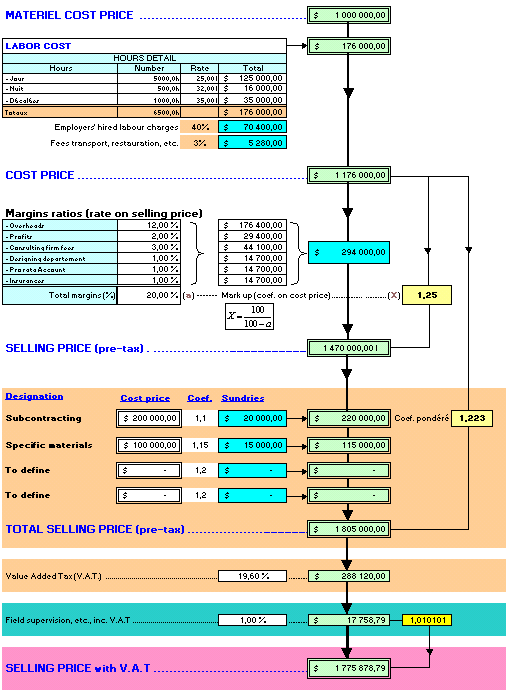| Estimate DevExcel | Margin (gross-profit) - Mark up |

| _You are in the heading |
|
|
The margin is calculated only one way: It is the difference between the selling price and the cost price. The Margin Rate (RM) It is the percentage of the margin (difference between:
the cost price (P.R) - and the selling price (P.V) applied on
the selling price (normally). RM = ((PR - PV) / PV) * 100 Determination of the coefficient of sale You want 20% of margin on the selling price, the
coefficient of sale will be determined on the following basis:
Practical commercial The difference between the two is not very significant,
but with the It is a manner for the trader of misleading his customer. Mr X, you See buy my product to me 1000 $, you
resell it 1300 $: To make a margin of 30%, Mr X must sell his product
1430 $, like his Calculation estimate (see calculation programme DevExcel) In a study of price or estimate it is advisable to affect a coefficient of sale which will cover the overheads, the specific expenses and the profit margin according to the cost price calculated in under detail of price. The overheads are expressed as a percentage evaluated
sales turnover total of the company and applied for the same percentage
in the price of the work. In the absence of more recent documents,
one will have to refer to the percentage of overheads noted at
the time of the financial year closure last of the company. The employers' loads on the wages can be charged directly to the cost of the labour or be integrated in the overheads of the company (In the example below, the employers' loads as well as the ancillary costs of transport and restoration are integrated directly on the cost of the labour).
Different coefficients of sale can be applied to certain stations, such as for example work of subcontracting, the real rate of margin or the balanced coefficient is given according to the price selling free taxes compared to spend, such as: materials, labour, subcontracting, etc. In certain case it is asked a percentage of ancillary
costs such as for example the expenses of controls or account
proportion calculated starting from the selling price all inclusive
of tax.
Last
update:
|
Copyright © 2003-2014 - ThermExcel - All Rights Reserved
